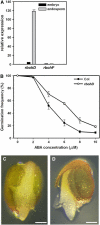Arabidopsis ABA INSENSITIVE4 regulates lipid mobilization in the embryo and reveals repression of seed germination by the endosperm
- PMID: 16844907
- PMCID: PMC1533976
- DOI: 10.1105/tpc.106.041277
Arabidopsis ABA INSENSITIVE4 regulates lipid mobilization in the embryo and reveals repression of seed germination by the endosperm
Abstract
Regulation of seed germination requires coordinate action by the embryo and surrounding endosperm. We used Arabidopsis thaliana to establish the relative roles of embryo and endosperm in the control of seed germination and seedling establishment. We previously showed that endospermic oil reserves are used postgerminatively via gluconeogenesis to fuel seedling establishment and that lipid breakdown is repressed by abscisic acid (ABA) in embryo but not endosperm tissues. Here, we use RNA amplification to describe the transcriptome of the endosperm and compare the hormone responses of endosperm and embryo tissues. We show that the endosperm responds to both ABA and gibberellin but that ABA in particular regulates nuclear but not plastid-encoded photosynthetic gene expression in the embryo. We also show that ABA INSENSITIVE4 (ABI4) expression is confined to the embryo, accounts for the major differences in embryo response to ABA, and defines a role for ABI4 as a repressor of lipid breakdown. Furthermore, ABI5 expression in the endosperm defines a second region of altered ABA signaling in the micropylar endosperm cap. Finally, embryo and endosperm ABA signaling mutants demonstrate the spatial specificity of ABA action in seed germination. We conclude that the single cell endosperm layer plays an active role in the regulation of seed germination in Arabidopsis.
Figures





Similar articles
-
The gibberellic acid signaling repressor RGL2 inhibits Arabidopsis seed germination by stimulating abscisic acid synthesis and ABI5 activity.Plant Cell. 2008 Oct;20(10):2729-45. doi: 10.1105/tpc.108.061515. Epub 2008 Oct 21. Plant Cell. 2008. PMID: 18941053 Free PMC article.
-
The Arabidopsis MYB96 Transcription Factor Is a Positive Regulator of ABSCISIC ACID-INSENSITIVE4 in the Control of Seed Germination.Plant Physiol. 2015 Jun;168(2):677-89. doi: 10.1104/pp.15.00162. Epub 2015 Apr 13. Plant Physiol. 2015. PMID: 25869652 Free PMC article.
-
Arabidopsis VQ18 and VQ26 proteins interact with ABI5 transcription factor to negatively modulate ABA response during seed germination.Plant J. 2018 Aug;95(3):529-544. doi: 10.1111/tpj.13969. Epub 2018 Jun 8. Plant J. 2018. PMID: 29771466
-
Molecular networks regulating Arabidopsis seed maturation, after-ripening, dormancy and germination.New Phytol. 2008;179(1):33-54. doi: 10.1111/j.1469-8137.2008.02437.x. Epub 2008 Apr 14. New Phytol. 2008. PMID: 18422904 Review.
-
ABSCISIC ACID INSENSITIVE 5 mediates light-ABA/gibberellin crosstalk networks during seed germination.J Exp Bot. 2022 Aug 11;73(14):4674-4682. doi: 10.1093/jxb/erac200. J Exp Bot. 2022. PMID: 35522989 Review.
Cited by
-
Analysis of Arabidopsis glucose insensitive growth mutants reveals the involvement of the plastidial copper transporter PAA1 in glucose-induced intracellular signaling.Plant Physiol. 2012 Jul;159(3):1001-12. doi: 10.1104/pp.111.191726. Epub 2012 May 11. Plant Physiol. 2012. PMID: 22582133 Free PMC article.
-
Distinct cell wall architectures in seed endosperms in representatives of the Brassicaceae and Solanaceae.Plant Physiol. 2012 Nov;160(3):1551-66. doi: 10.1104/pp.112.203661. Epub 2012 Sep 6. Plant Physiol. 2012. PMID: 22961130 Free PMC article.
-
Histidine Regulates Seed Oil Deposition through Abscisic Acid Biosynthesis and β-Oxidation.Plant Physiol. 2016 Oct;172(2):848-857. doi: 10.1104/pp.16.00950. Epub 2016 Aug 4. Plant Physiol. 2016. PMID: 27493214 Free PMC article.
-
ICE1 and ZOU determine the depth of primary seed dormancy in Arabidopsis independently of their role in endosperm development.Plant J. 2019 Apr;98(2):277-290. doi: 10.1111/tpj.14211. Epub 2019 Feb 18. Plant J. 2019. PMID: 30570804 Free PMC article.
-
Hydro-Electro Hybrid Priming Promotes Carrot (Daucus carota L.) Seed Germination by Activating Lipid Utilization and Respiratory Metabolism.Int J Mol Sci. 2021 Oct 14;22(20):11090. doi: 10.3390/ijms222011090. Int J Mol Sci. 2021. PMID: 34681749 Free PMC article.
References
-
- Acevedo-Hernández, G.J., Leon, P., and Herrera-Estrella, L.R. (2005). Sugar and ABA responsiveness of a minimal RBCS light-responsive unit is mediated by direct binding of ABI4. Plant J. 43 506–519. - PubMed
-
- Bentsink, L., and Koornneef, M. (2002). Seed dormancy and germination. In The Arabidopsis Book, C.R. Somerville and E.M. Meyerowitz, eds (Rockville, MD: American Society of Plant Biologists), doi/10.1199/tab.0050, http://www.aspb.org/publications/arabidopsis/. - PMC - PubMed
-
- Berger, F. (1999). Endosperm development. Curr. Opin. Plant Biol. 2 28–32. - PubMed
-
- Bewley, J.D. (1997. b). Breaking down the walls – A role for endo-β-mannanase in release from seed dormancy? Trends Plant Sci. 2 464–469.
Publication types
MeSH terms
Substances
LinkOut - more resources
Full Text Sources
Other Literature Sources
Molecular Biology Databases
Miscellaneous

